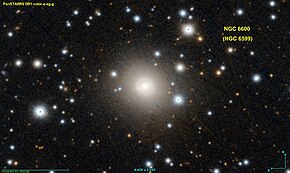NGC 6600
| NGC 6600 | |
|---|---|
 NGC 6600 Captured by PAN-STARRS | |
| Observation data (J2000 epoch) | |
| Constellation | Hercules |
| Right ascension | 18h 19m 41.30s[1] |
| Declination | +63° 06′ 42.0″[1] |
| Redshift | 0.018079[1] |
| Distance | 310 Mly (93 Mpc)[1] |
| Apparent magnitude (V) | 14.6[1] |
| Characteristics | |
| Type | Sc[1] |
| Size | 100,000 ly |
| Apparent size (V) | 1.23′ × 1.148′[1] |
| Other designations | |
| NGC 6599,[1] PGC 61655, UGC 11178, CGCG 142-031, MCG +04-43-019 | |
NGC 6600 (NGC 6599 duplicate[2]) is a lenticular galaxy roughly 310 million light-years away in the constellation Hercules.[1] NGC 6600 was discovered in 1864 by Albert Marth.[3] Unlike our own Milky Way, NGC 6600 boasts a tightly wound structure, swirling with stars and gas.[4][1]
Characteristics
[edit]NGC 6600 appears as combination of blue and white hues, these colors emanate from its young, hot stars, clustered primarily in the galaxy's spiral arms.[5] As these stars age and cool down, their colors shift towards red.[6][4]
One of the key tools astronomers use to understand galaxies like NGC 6600 is redshift.[3] This phenomenon occurs when light waves from an object moving away from us stretch out, shifting their colors towards the red end of the spectrum.[6][3]
Spiral arms
[edit]NGC 6600's spiral arms play a crucial role in the galaxy's evolution.[5] As gas and dust flow inwards along these arms, they condense and form new stars.[3][7] These newborn stars, with their intense radiation and stellar winds, sculpt the arms further, creating a continuous cycle of star formation and evolution.[1]
The exact cause of its tightly wound spiral arms remains a mystery. Some astronomers believe it might be due to a past interaction with another galaxy, while others propose it could be a natural consequence of the galaxy's internal dynamics.[6]
References
[edit]- ^ a b c d e f g h i j k "NGC 6599 - Lenticular Galaxy in Hercules | TheSkyLive.com". theskylive.com. Retrieved 2024-01-16.
- ^ Astronomy, Go. "NGC 6600 | duplicate in Hercules | NGC List | GO ASTRONOMY". Go-Astronomy.com.
- ^ a b c d "NGC 6599 - Galaxy - SKY-MAP". www.wikisky.org. Retrieved 2024-01-16.
- ^ a b "By Name | NASA/IPAC Extragalactic Database". ned.ipac.caltech.edu. Retrieved 2024-01-17.
- ^ a b Ford, Dominic. "NGC6599 (Galaxy)". In-The-Sky.org. Retrieved 2024-01-17.
- ^ a b c Ford, Dominic. "The New General Catalogue (NGC)". In-The-Sky.org. Retrieved 2024-01-17.
- ^ "Digitized Sky Survey (DSS) Images of NGC/IC Objects". ngcicproject.observers.org. Retrieved 2024-01-17.
